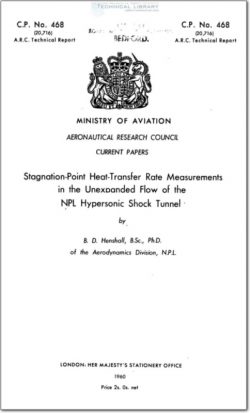ARC-CP-468
- Version
- 202 Downloads
- 3.35 MB File Size
- 1 File Count
- July 22, 2016 Create Date
- July 22, 2016 Last Updated
Stagnation Point Heat Transfer Rate Measurements in the Unexpanded Flow of the NPL Hypersonic Shock Tunnel

The N.P.L. hypersonic shock tunnel was designed as a facility
for the investigation of hypersonic aerodynamic problems; the conditions
in the working section.nay be adjusted to correspond to hypersonic flight
in the stratOSphere with one or more of the following parameters ~
stagnation enthalpy, altitude, velocity and Mach number — sinmlated
correctly. Some typical operating conditions are discussed in Refs.1 and 2.
One hypersonic flow problem, the stagnation point heat transfer
rate to a blunt body, may be studied in the straight channel (unexpanded
flow) of a shock tunnel. In this case the difference between the flight
and test mach numbers can be neglected because the flow fields in the
neighbourhood of the stagnation point are virtually independent of mach
number. Therefore duplication of stagnation pressure and stagnation
enthalpy should be sufficient to define complete simulation of flight
conditions in the shock tunnel experiments.
This paper gives a description of an experimental investigation
of the heat transfer rates to the stagnation points of g—inch diameter
glass Sphere models in unexpanded shock tunnel airflow for a range of
initial shock tunnel conditions and, therefore, stagnation temperatures
and pressures. The eXperimental results Show good agreement with
experimental results obtained at the N.A.C.A. La ley Laboratory (Ref.3)
and the A.V.C.O. Research Laboratory (Reflag and 5 . All the experimental
results are shown to be significantly lower than the theoretical
predictions of Fay and Riddell (Ref.6).
The results reported below were made in the 3—inch diameter
channel of the N.P.L. hypersonic shock tunnel. In all the experiments
the driver gas in the chamber was *cold', i.e. room temperature, hydrogen
and the driven gas in the channel was undried room temperature air. A
description of the shock tunnel and its instrumentation is given in Ref.2
and details of the method of shock speed measurement and determination of
the duration of the hot flow behind the primary shock wave appear in
Ref.7. A schematic diagram of the instrumentation of the N.P.L. hypersonic
shock tunnel is shown in Fig.1. A1, Bi, 01 etc. A;, 732, Cu, etc. are all
thin film resistance thermometer stations. In the current series of tests
of heat transfer rate measurements, the %—inch diameter soda glass model
was mounted in the shock tunnel at the position labelled F1 in Fig.1. This
station is 31% feet from the primary diaphragm. The incident shock Mach
number M3 was varied from 6.5 to 10.5 in this series of experiments
by variation of the initial channel pressure p1 and/or the initial
chamber pressure.
| File | Action |
|---|---|
| ARC-CP-468 Stagnation Point Heat Transfer Rate Measurements in the Unexpanded Flow of the NPL Hypersonic Shock Tunnel.pdf | Download |
Comment On This Post